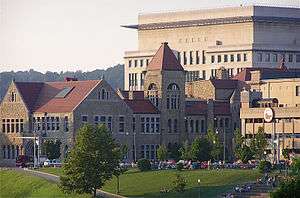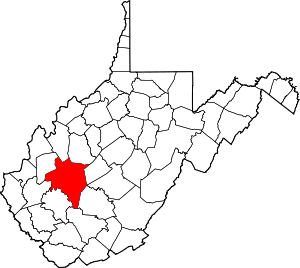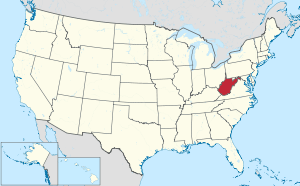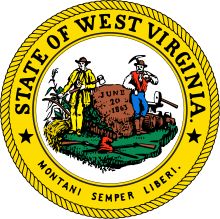Kanawha County, West Virginia
Kanawha County (/kəˈnɔː/ kə-NAW or /kəˈnɔːə/ kə-NAW-ə) is a county in the U.S. state of West Virginia. As of the 2010 census, the population was 193,063,[1] making it West Virginia's most populous county. Its county seat is Charleston,[2] the state capital. Kanawha County is part of the Charleston, WV Metropolitan Statistical Area.
Kanawha County | |
|---|---|
 Kanawha County Courthouse in Charleston | |
 Seal | |
 Location within the U.S. state of West Virginia | |
 West Virginia's location within the U.S. | |
| Coordinates: 38°20′N 81°32′W | |
| Country | |
| State | |
| Founded | October 5, 1789 |
| Named for | Kanawha River |
| Seat | Charleston |
| Largest city | Charleston |
| Area | |
| • Total | 911 sq mi (2,360 km2) |
| • Land | 902 sq mi (2,340 km2) |
| • Water | 9.3 sq mi (24 km2) 1.0%% |
| Population (2010) | |
| • Total | 193,063 |
| • Estimate (2019) | 178,124 |
| • Density | 210/sq mi (82/km2) |
| Time zone | UTC−5 (Eastern) |
| • Summer (DST) | UTC−4 (EDT) |
| Congressional district | 2nd |
| Website | www |
History
The county began taking formation on November 14, 1788, under authorization of the Virginia General Assembly and was founded on October 5, 1789. The county was named for the Kanawha River, which in turn was named after a Native American tribe that lived in the area.[3] During the American Civil War, a number of state infantry and cavalry regiments were organized in the county for both Confederate Army and Union Army service.
In 1863, West Virginia's counties were divided into civil townships, with the intention of encouraging local government. This proved impractical in the heavily rural state, and in 1872 the townships were converted into magisterial districts.[4] Kanawha County was divided into ten districts: Big Sandy, Cabin Creek, Charleston, Elk, Jefferson, Loudon, Malden, Poca,[lower-roman 1] Union, and Washington. In the 1970s the historic districts were consolidated into five new magisterial districts: District 1, District 2, District 3, District 4, and District 5. A District 6 was created in the 1980s, but in the 1990s the county was redistricted again, reducing the number of magisterial districts to four: District 1, District 2, District 3, and District 4.[5]
Kanawha County was the site of a bloody miners' strike in 1912, and a school textbook controversy in 1974, that resulted in bombings, and received national attention.
Geography
According to the U.S. Census Bureau, the county has a total area of 911 square miles (2,360 km2), of which 902 square miles (2,340 km2) is land and 9.3 square miles (24 km2) (1.0%) is water.[6] It is the fourth-largest county in West Virginia by area.
Adjacent counties
- Roane County (north)
- Clay County (northeast)
- Nicholas County (east)
- Fayette County (east)
- Raleigh County (southeast)
- Boone County (south)
- Lincoln County (southwest)
- Putnam County (west)
- Jackson County (northwest)
Major highways
.svg.png)
.svg.png)
.svg.png)














Demographics
| Historical population | |||
|---|---|---|---|
| Census | Pop. | %± | |
| 1800 | 3,239 | — | |
| 1810 | 3,866 | 19.4% | |
| 1820 | 6,399 | 65.5% | |
| 1830 | 9,326 | 45.7% | |
| 1840 | 13,567 | 45.5% | |
| 1850 | 15,353 | 13.2% | |
| 1860 | 16,150 | 5.2% | |
| 1870 | 22,349 | 38.4% | |
| 1880 | 32,466 | 45.3% | |
| 1890 | 42,756 | 31.7% | |
| 1900 | 54,696 | 27.9% | |
| 1910 | 81,457 | 48.9% | |
| 1920 | 119,650 | 46.9% | |
| 1930 | 157,667 | 31.8% | |
| 1940 | 195,619 | 24.1% | |
| 1950 | 239,629 | 22.5% | |
| 1960 | 252,925 | 5.5% | |
| 1970 | 229,515 | −9.3% | |
| 1980 | 231,414 | 0.8% | |
| 1990 | 207,619 | −10.3% | |
| 2000 | 200,073 | −3.6% | |
| 2010 | 193,063 | −3.5% | |
| Est. 2019 | 178,124 | [7] | −7.7% |
| U.S. Decennial Census[8] 1790–1960[9] 1900–1990[10] 1990–2000[11] 2010–2018[1] | |||
2000 census
As of the census[12] of 2000, there were 200,073 people, 86,226 households, and 55,960 families living in the county. The population density was 222 people per square mile (86/km²). There were 93,788 housing units at an average density of 104 per square mile (40/km²). The racial makeup of the county was 90.46% White, 6.97% Black or African American, 0.21% Native American, 0.85% Asian, 0.02% Pacific Islander, 0.21% from other races, and 1.27% from two or more races. 0.59% of the population were Hispanics or Latinos of any race.
There were 86,226 households out of which 26.50% had children under the age of 18 living with them, 49.00% were married couples living together, 12.30% had a female householder with no husband present, and 35.10% were non-families. 30.80% of all households were made up of individuals and 12.50% had someone living alone who was 65 years of age or older. The average household size was 2.28 and the average family size was 2.84.
The age distribution was 21.30% under the age of 18, 8.40% from 18 to 24, 28.10% from 25 to 44, 25.60% from 45 to 64, and 16.50% who were 65 years of age or older. The median age was 40 years. For every 100 females, there were 90.70 males. For every 100 females age 18 and over, there were 87.10 males.
The median income for a household in the county was $33,766, and the median income for a family was $42,568. Males had a median income of $33,842 versus $24,188 for females. The per capita income for the county was $20,354. About 11.20% of families and 14.40% of the population were below the poverty line, including 20.60% of those under age 18 and 10.50% of those age 65 or over.
2010 census
As of the 2010 United States Census, there were 193,063 people, 84,201 households, and 52,172 families living in the county.[13] The population density was 214.1 inhabitants per square mile (82.7/km2). There were 92,618 housing units at an average density of 102.7 per square mile (39.7/km2).[14] The racial makeup of the county was 89.1% white, 7.3% black or African American, 1.0% Asian, 0.2% American Indian, 0.3% from other races, and 2.0% from two or more races. Those of Hispanic or Latino origin made up 0.9% of the population.[13] In terms of ancestry, 14.8% were German, 14.2% were Irish, 13.9% were English, and 13.4% were American.[15]
Of the 84,201 households, 27.1% had children under the age of 18 living with them, 44.3% were married couples living together, 13.1% had a female householder with no husband present, 38.0% were non-families, and 32.5% of all households were made up of individuals. The average household size was 2.26 and the average family size was 2.84. The median age was 42.4 years.[13]
The median income for a household in the county was $42,669 and the median income for a family was $54,203. Males had a median income of $42,522 versus $31,754 for females. The per capita income for the county was $25,439. About 9.7% of families and 13.7% of the population were below the poverty line, including 20.5% of those under age 18 and 8.3% of those age 65 or over.[16]
Politics
Kanawha County was dominated by the Democratic Party for much of the 20th century, albeit to a lesser extent than much of West Virginia. However, since 2004 it has been won by Republicans in presidential elections, although as an urban county the swing to the Republicans has not been as vast as in much of the rest of the state.
| Year | Republican | Democratic | Third parties |
|---|---|---|---|
| 2016 | 57.0% 43,850 | 36.8% 28,263 | 6.2% 4,775 |
| 2012 | 54.9% 41,364 | 43.1% 32,480 | 2.0% 1,468 |
| 2008 | 49.4% 40,952 | 49.0% 40,594 | 1.6% 1,341 |
| 2004 | 50.5% 44,430 | 48.9% 43,010 | 0.6% 488 |
| 2000 | 48.0% 36,809 | 50.3% 38,524 | 1.8% 1,337 |
| 1996 | 38.3% 29,311 | 52.8% 40,357 | 8.9% 6,827 |
| 1992 | 38.4% 31,358 | 46.9% 38,315 | 14.7% 11,998 |
| 1988 | 48.0% 38,140 | 51.7% 41,144 | 0.3% 258 |
| 1984 | 57.5% 51,499 | 42.3% 37,832 | 0.2% 211 |
| 1980 | 46.4% 42,604 | 46.7% 42,829 | 6.9% 6,327 |
| 1976 | 44.1% 42,213 | 55.9% 53,602 | |
| 1972 | 63.1% 65,021 | 36.9% 38,032 | |
| 1968 | 41.8% 41,712 | 46.7% 46,650 | 11.5% 11,524 |
| 1964 | 35.3% 38,383 | 64.8% 70,511 | |
| 1960 | 51.2% 57,130 | 48.8% 54,484 | |
| 1956 | 53.8% 58,597 | 46.2% 50,289 | |
| 1952 | 51.0% 56,861 | 49.0% 54,540 | |
| 1948 | 43.5% 41,144 | 56.2% 53,213 | 0.4% 338 |
| 1944 | 43.5% 36,488 | 56.5% 47,400 | |
| 1940 | 40.9% 40,113 | 59.1% 57,932 | |
| 1936 | 41.0% 35,387 | 58.9% 50,801 | 0.1% 113 |
| 1932 | 47.4% 35,455 | 51.6% 38,617 | 1.0% 749 |
| 1928 | 58.2% 35,788 | 41.5% 25,563 | 0.3% 184 |
| 1924 | 49.1% 26,018 | 42.9% 22,726 | 8.0% 4,207 |
| 1920 | 54.3% 23,781 | 44.1% 19,284 | 1.6% 704 |
| 1916 | 48.1% 10,096 | 49.0% 10,276 | 2.9% 598 |
| 1912 | 10.0% 1,780 | 37.3% 6,658 | 52.8% 9,431[18] |
Elected officials
| Agency | Elected Official |
|---|---|
| Kanawha County Commission | Commissioner W. Kent Carper, President Commissioner Ben Salango Commissioner Henry "Hoppy" Shores |
| Kanawha County Assessor | Sallie Robinson |
| Kanawha County Circuit Clerk | Cathy Gatson |
| Kanawha County Clerk | Vera McCormick |
| Kanawha County Prosecutor | Charles "Chuck" Miller |
| Kanawha County Sheriff | Michael Y. Rutherford |
Economy
According to the 2010 U.S. Census there are approximately 5,481 private sector businesses within Kanawha County. There are 89,768 people that are currently employed that live in Kanawha County.[19]
Recreation
| Parks | Golf |
|---|---|
| Coonskin Park | Coonskin Golf Course |
| Shawnee Park | Shawnee Golf Course |
| Meadowood Park | Edgewood Country Club |
| Pioneer Park | Little Creek Golf Course |
| Wallace Hartman Nature Preserve | Sleepy Hollow Golf Club |
| Cato Park | Sandy Brae Golf Course |
| Ridenour Park | Berry Hills Country Club |
| Big Bend Park | Big Bend Golf Course |
| Kanawha State Forest | |
| Saint Albans City Park |
Events
Attractions
- Clay Center (West Virginia)
- West Virginia State Capitol
- West Virginia Cultural Center
- South Charleston Mound
- Mardi Gras Casino and Resort
- Charleston Civic Center
- Heritage Tower Museum
Sports
- West Virginia Power - Baseball team
- West Virginia Chaos - Soccer club
Communities
Cities
- Charleston (county seat)
- Dunbar
- Marmet
- Montgomery (part)
- Nitro (part)
- Smithers (part)
- South Charleston
- St. Albans
Magisterial districts
- District 1
- District 2
- District 3
- District 4
Census-designated places
Unincorporated communities
- Aarons
- Acme
- Acup
- Airport Village
- Amandaville
- Amelia
- Annfred
- Arborland Acres
- Barren Creek
- Blackhawk
- Blakeley
- Blount
- Blue Creek
- Blundon
- Bream
- Brounland
- Burnwell
- Cabin Creek
- Carbon
- Cinco
- Coalburg
- Coalridge
- Coco
- Corton
- Crede
- Crown Hill
- Davis Creek
- Dawes
- Decota
- Dial
- Diamond
- Dickinson
- Donwood
- Dry Branch
- Dungriff
- Dupont City
- East Nitro
- East Side
- Edgewood
- Elk
- Elk Forest
- Elk Hills
- Emmons (part)
- Eskdale
- Etowah
- Falling Rock
- Ferrell
- Fivemile
- Forest Hills
- Forks of Coal
- Fort Hill
- Frame
- Gallagher
- Giles
- Green Valley
- Greencastle
- Grippe
- Guthrie
- Hansford
- Hernshaw
- Hicumbottom
- Highlawn
- Hillsdale
- Hitop
- Holly
- Hollygrove
- Hollyhurst
- Hugheston
- Institute
- Island Branch
- Ivydale
- Jarrett
- Jarretts Ford
- Joplin
- Kanawha City
- Kanawha Estates
- Kayford
- Kelly Hill
- Kendalia
- Laing
- Leewood
- Loudendale
- Lower Falls
- Mammoth
- Meadowbrook
- Mink Shoals
- Pocatalico
- Pond Gap
- Port Amherst
- Putney
- Quick
- Quincy
- River Bend
- Rocky Fork
- Rock Lake Village
- Rutledge
- Sanderson
- Tyler Heights
- Tyler Mountain
Notable people
- Robert Alexander, NFL football player
- Anthony Bass, NFL football player
- George Crumb, composer
- Aaron Dobson, Super Bowl champion football player
- Ryan Dorsey, actor
- Conchata Ferrell, actress and three-time Primetime Emmy Award nominee, best known for her role as Berta on Two and a Half Men
- Jennifer Garner, actress and Golden Globe and SAG award winner
- Elizabeth Harden Gilmore, business leader and civil rights advocate
- Gary Gregor, NBA basketball player
- Alex Hawkins, two-time NFL champion football player
- Alexis Hornbuckle, two-time WNBA champion basketball player
- T. D. Jakes, megachurch pastor
- Carl Lee, NFL football player
- Earl Lloyd, Basketball Hall of Fame inductee and the first African-American basketball player to play in an NBA game
- Kathy Mattea, country music and bluegrass singer
- Renee Montgomery, two-time WNBA champion basketball player
- Randy Moss, Pro Football Hall of Fame inductee and holder of the NFL record for receiving touchdowns in a season
- Lou Myers, actor, best known for his role as Vernon Gaines on A Different World
- Les Palmer, NFL champion football player
- Phil Pfister, strongman competitor and winner of the 2006 World's Strongest Man competition
- Kristen Ruhlin, actress
- Ryan Switzer, NFL football player
- Booker T. Washington, highly influential educator, author, orator, presidential advisor, and co-founder of the Tuskegee Institute
- Jerry West, Basketball Hall of Fame inductee, nine-time NBA champion as both a player and an executive, and the basis for the silhouette on the NBA logo since 1971
See also
Footnotes
- Originally "Pocatalico".
References
- "State & County QuickFacts". United States Census Bureau. Archived from the original on June 7, 2011. Retrieved January 10, 2014.
- "Find a County". National Association of Counties. Archived from the original on May 31, 2011. Retrieved June 7, 2011.
- "West Virginia Counties". West Virginia Division of Culture and History. Archived from the original on September 23, 2001. Retrieved February 24, 2014. (WV County Etymology)
- Otis K. Rice & Stephen W. Brown, West Virginia: A History, 2nd ed., University Press of Kentucky, Lexington (1993), p. 240.
- United States Census Bureau, U.S. Decennial Census, Tables of Minor Civil Divisions in West Virginia, 1870–2010.
- "2010 Census Gazetteer Files". United States Census Bureau. August 22, 2012. Retrieved July 24, 2015.
- "Population and Housing Unit Estimates". Retrieved March 29, 2020.
- "U.S. Decennial Census". United States Census Bureau. Retrieved January 10, 2014.
- "Historical Census Browser". University of Virginia Library. Retrieved January 10, 2014.
- "Population of Counties by Decennial Census: 1900 to 1990". United States Census Bureau. Retrieved January 10, 2014.
- "Census 2000 PHC-T-4. Ranking Tables for Counties: 1990 and 2000" (PDF). United States Census Bureau. Retrieved January 10, 2014.
- "U.S. Census website". United States Census Bureau. Retrieved 2011-05-14.
- "DP-1 Profile of General Population and Housing Characteristics: 2010 Demographic Profile Data". United States Census Bureau. Archived from the original on February 13, 2020. Retrieved April 3, 2016.
- "Population, Housing Units, Area, and Density: 2010 - County". United States Census Bureau. Archived from the original on February 13, 2020. Retrieved April 3, 2016.
- "DP02 SELECTED SOCIAL CHARACTERISTICS IN THE UNITED STATES – 2006-2010 American Community Survey 5-Year Estimates". United States Census Bureau. Archived from the original on February 13, 2020. Retrieved April 3, 2016.
- "DP03 SELECTED ECONOMIC CHARACTERISTICS – 2006-2010 American Community Survey 5-Year Estimates". United States Census Bureau. Archived from the original on February 13, 2020. Retrieved April 3, 2016.
- Leip, David. "Dave Leip's Atlas of U.S. Presidential Elections". uselectionatlas.org. Retrieved March 27, 2018.
- The leading "other" candidate, Progressive Theodore Roosevelt, received 3,071 votes, while Socialist candidate Eugene Debs received 1,780 votes.
- "State & County QuickFacts". Archived from the original on June 7, 2011.
- "Home | FestivAll". www.festivallcharleston.com. Retrieved March 27, 2018.
- "Live on the Levee". liveontheleveecharleston.com. Retrieved March 27, 2018.
- "Vandalia Gathering". www.wvculture.org. Retrieved March 27, 2018.
- "South Charleston Convention & Visitors Bureau | 18th Annual Barbecue Ribfest". southcharlestonwv.org. Retrieved March 27, 2018.
- "2017 Charleston Rod Run & Doo Wop". www.charlestonwvcarshow.com. Retrieved March 27, 2018.
- "WV MetroNews – Pinch Lays Claim To Oldest Reunion". wvmetronews.com. Retrieved March 27, 2018.
- "Archived copy". Archived from the original on December 26, 2012. Retrieved February 28, 2013.CS1 maint: archived copy as title (link)
Further reading
- Scott A. MacKenzie. "The Slaveholders' War: The Secession Crisis in Kanawha County, Western Virginia, 1860-1861," West Virginia History: A Journal of Regional Studies - New Series, Volume 4, Number 1, Spring 2010, pp. 33–57 in Project MUSE
External links
- Kanawha County Commission
- Kanawha County Public Library
- Kanawha County Schools
- WVGenWeb Kanawha County
- Kanawha County Obituary Archive
- Convention & Visitors Bureau
- Charleston, WV - http://www.charlestonwv.com/
- Dunbar, WV - http://www.wvcommerce.org/travel/travelplanner/attraction/Dunbar-Convention-and-Visitors-Bureau-CVB/3843/default.aspx
- Nitro, WV - https://web.archive.org/web/20130727150319/http://nitrowvcvb.org/
- South Charleston, WV - https://web.archive.org/web/20121019071540/http://www.southcharlestonwv.org/SCCVB/Welcome.html
